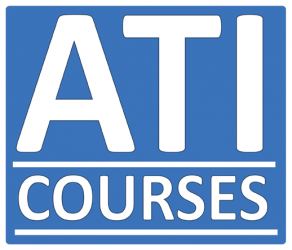ATI's Multi-Target Tracking and Multi-Sensor Data Fusion course
The objective of this course is to introduce engineers, scientists, managers, and military operations personnel to the fields of radar tracking, data fusion and to the key technologies which are available today for application to this field. The course is designed to be rigorous where appropriate, while remaining accessible to students without a specific scientific background in this field. The course will start from the fundamentals and move to advanced concepts. This course will identify and characterize the principal components of typical tracking systems. A variety of techniques for addressing different aspects of the tracking data fusion problem will be described. For example, different techniques are required for the assimilation of "time-late" data than those used for "real-time" data. Real world examples of data fusion systems used by both the Navy and the Marines will be presented and discussed. This course will also use specific illustrative examples to show the tradeoffs and systems issues between application of different techniques.
What you will learn:
- State Estimation Techniques – Kalman Filter, constant-gain filters.
- Non-linear filtering – When is it needed? Extended Kalman Filter.
- Techniques for angle-only tracking.
- Tracking algorithms, their advantages and limitations, including:
-
- Nearest Neighbor
- Probabilistic Data Association
- Multiple Hypothesis Tracking
- Interactive Multiple Model (IMM)
- How to handle maneuvering targets.
- Track initiation – recursive and batch approaches.
- Architectures for sensor fusion.
- Sensor alignment – Why do we need it and how do we do it?
- Attribute Fusion, including Bayesian methods, Dempster-Shafer, Fuzzy Logic.
Course Outline:
- Introduction. Basic concepts & definitions. Target motion models, measurement models, coordinate systems.
- The Kalman Filter. State estimation – least squares and Kalman filtering.
- Other Linear Filters. Constant-gain and table look-up filters. Comparative performance.
- Non-Linear Filters. When are they necessary? Extended Kalman Filter, Unscented Filter, Particle Filters.
- Angle-Only Tracking. EKF, pseudo-linear, modified polar coordinates.
- Maneuvering Targets: Adaptive Techniques. Noise models, maneuver detection, adaptive processes.
- Maneuvering Targets: Multiple Model Approaches. Non-switching and switching models. Interacting Multiple Model. IMM design. Examples.
- Single Target Correlation & Association. Correlation processing. Nearest neighbor, assignment algorithms.
- Track Initiation, Confirmation & Deletion. M/N and sequential tests for confirmation. Track deletion criteria.
- Using Measured Range Rate (Doppler). Implementation of constant-gain, Kalman and EKF using measured range rate.
- Multitarget Correlation & Association. Extended nearest neighbor, optimal & sub-optimal assignment.
- Probabilistic Data Association. Examples and implementation issues.
- Multiple Hypothesis Approaches. Examples. Hypothesis merging and pruning.
- Coordinate Conversions. Conversions between local systems and from local to global. Compensation for sensor motion.
- Multiple Sensors. JDL Data Fusion Model. Levels of fusion.
- Data Fusion Architectures. Fusion architectures. Report-to-Track and Track-to-Track. Associated Measurement Reports
- Fusion of Data From Multiple Radars. Comparison of Report-to-Track and Track-to-Track processes. Colocated and non-colocated sensors.
- Fusion of Data From Multiple Angle-Only Sensors. Correlation. Triangulation techniques for non-colocated.
- Fusion of Data From Radar and Angle-Only Sensor. Correlation techniques. Differences between collocated and non-colocated sensors.
- Sensor Alignment. Types of alignment problems. Impact of biases. Techniques.
- Fusion of Target Type and Attribute Data. Bayesian, Dempster-Shafer, Fuzzy Logic. Impact of attribute data on correlation.
- Performance Metrics. Quantizing system performance. Measures of track accuracy, continuity, initiation time, etc.
Speaker and Presenter Information
Stan Silberman is a member of the Senior Technical Staff of the Applied Physics Laboratory. He has over 30 years of experience in tracking, sensor fusion, and radar systems analysis and design for the Navy, Marine Corps, Air Force, and FAA. Recent work has included the integration of a new radar into an existing multisensor system and in the integration, using a multiple hypothesis approach, of shipboard radar and ESM sensors. Previous experience has included analysis and design of multiradar fusion systems, integration of shipboard sensors including radar, IR and ESM, integration of radar, IFF, and time-difference-of-arrival sensors with GPS data sources, and integration of multiple sonar systems on underwater platforms.Relevant Government Agencies
Air Force, Army, Navy & Marine Corps, Intelligence Agencies, DOD & Military, Office of the President (includes OMB), Dept of Agriculture, Dept of Commerce, Dept of Education, Dept of Energy, Dept of Health & Human Services, Dept of Homeland Security, Dept of Housing & Urban Development, Dept of the Interior, Dept of Justice, Dept of Labor, Dept of State, Dept of Transportation, Dept of Treasury, Dept of Veterans Affairs, EPA, GSA, USPS, SSA, NASA, Other Federal Agencies, Legislative Agencies (GAO, GPO, LOC, etc.), Judicial Branch Agencies, State Government, County Government, City Government, Municipal Government, CIA, FEMA, Office of Personnel Management, Coast Guard, National Institutes of Health, FAA, Census Bureau, USAID
This event has no exhibitor/sponsor opportunities
When
Tue-Thu, May 10-12, 2011, 8:30am - 4:30pm
Where
Doubletree Hotel Columbia
5485 Twin Knolls Road
Columbia, MD 21140
Get directions
Website
Click here to visit event website
Organizer
ATI Courses





